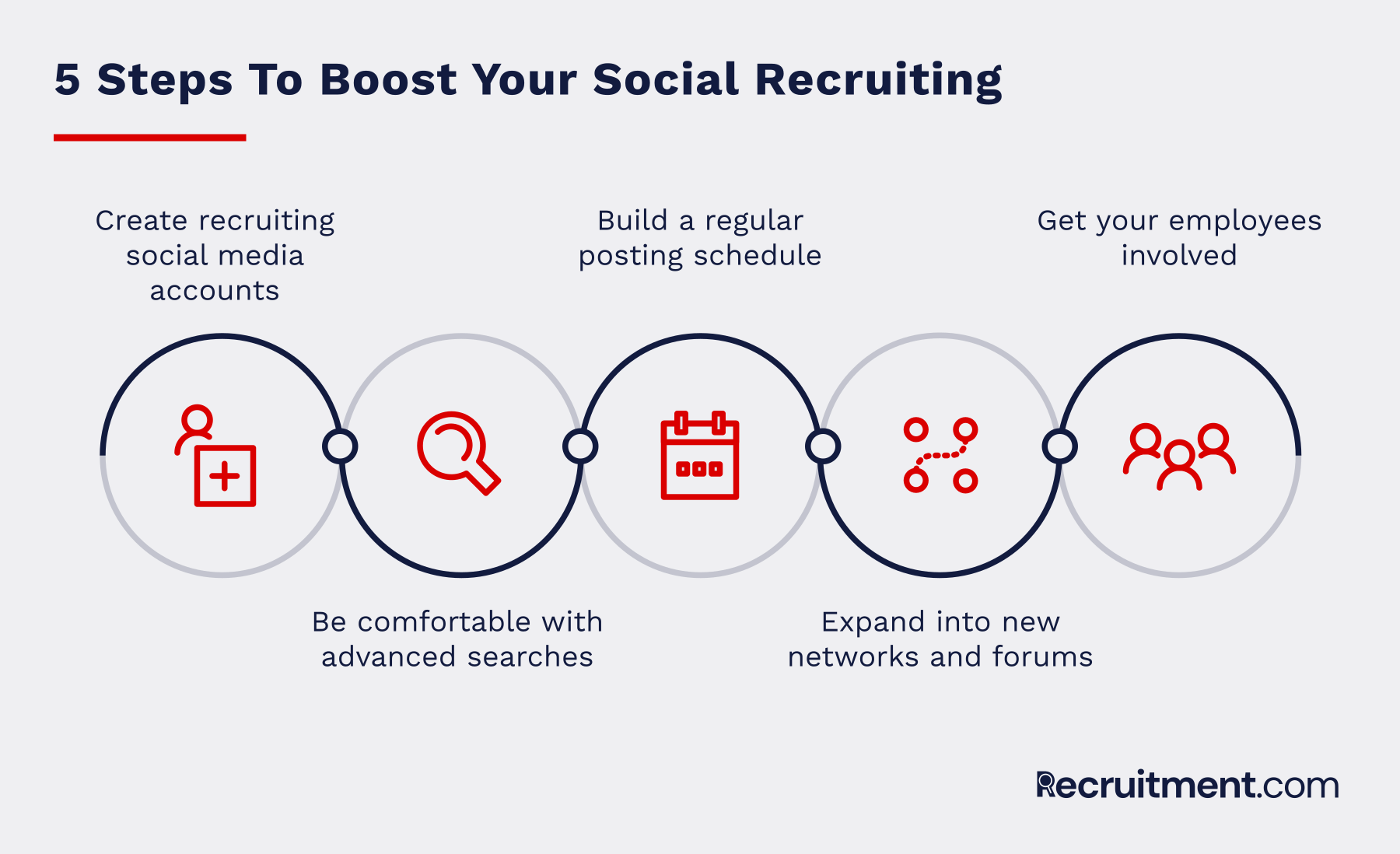Why You Need A Social Media Recruiting Strategy (And How To Make One)

Dann Albright is a writer and researcher specializing in human resources and finance.
Using social media to brand your company is the first step in an effective social media recruiting campaign.
In 2011, 56% of companies used social media for recruitment. In 2016, that number was up to 84%. That's a huge jump in just five years.
And that trend is set to continue.
Companies have come to realize that social media recruiting gets them great candidates. Organizations can no longer ignore social media as a source of talent.
Whether it's posting jobs on LinkedIn or reaching out to passive candidates on Twitter, recruiters and talent managers have a huge opportunity.
They can pursue the best talent available via social media or they can continue using the same methods they've used in the past. Methods that are slower, more costly, and give less insight into whether a candidate will be a great fit at the company.
Let's take a look at social media recruiting, why companies are doing it, why it's important, and how you can do it better.
90% Of Companies Are On Social Media. That Doesn’t Mean They’re Doing It Right.
Before we talk specifically about recruiting on social media, we have to talk about brand usage of social media in general (it's related, but it'll take a second to become clear how). Companies are definitely getting on the social bandwagon—90% of them, according to Hootsuite.
But not everyone is taking full advantage. A quick look at any social media platform shows that many companies don't know what they're doing. They post infrequently, don't interact with their followers, and keep the focus on themselves.
And that's costing them because branding via social media is a prerequisite to effective recruiting.
Why? Because the modern job seeker is looking for more than a position.
Millennials are now the largest generation in the workforce, and they have a well-documented attraction to purpose-driven careers. They want to know that they're joining a company that does more than sell products. It needs to take care of its employees and meet social and environmental obligations around the world.
Positioning your company as one that millennials would love to work for is one of the best things you can do to cut your recruiting time. When people know what your company stands for and how it meets its social obligations, they'll jump on an opportunity to join the organization.
And that means you'll have qualified candidates knocking on your door as soon as you post an opening.

5 Steps to Boost Your Social Recruiting
Ready to start recruiting on social media? Here are five things you can do to get started:
1. Create Recruiting Social Media Accounts
Many companies have specific social media accounts for recruiting. You'll often see "careers" or "jobs" in their usernames.
This is a great way to build connections with potential candidates. Reach out to people to build connections, let them know that you're recruiting, and encourage referrals.
Want a great example? Check out @DisneyCareers on Twitter. They share articles about the company, post open jobs, and share quotes from leaders:

Candidates Sourced From Social Media Are High-Quality
But speed isn't the only benefit of social media recruiting.
Recruiters also rate candidates sourced from social media as very high-quality.
When you see these statistics and understand how today's talent looks for jobs, the benefits of social media recruiting become clear. You can:
- Show off what makes your company a great place to work,
- Build connections with potential future recruits before you need to fill a position,
- Target very specific candidates with your outreach,
- Generate demand for your jobs,
- Reach passive candidates,
- Encourage referrals
It all works together in a solid social media recruiting strategy.
But it takes a lot more than just posting once a week on Facebook. We'll talk about that momentarily. First, let's talk about why social media recruiting is such a cost-efficient way of finding job candidates.
Social Media Recruiting Can Generate Huge Returns
Finding job candidates can be an expensive process. It could several hundreds of dollars in job ads for each board. That could be over $1,000 if you post to multiple places. Career events can be a couple hundred more.
Social media, on the other hand, just takes time and effort (unless you're placing ads, in which case there will be added cost). And they're well spent.
A 2013 survey from Jobvite found that 43% of companies were spending less than $1,000 per month on social recruiting. But 60% of those companies valued their hires from social media at greater than $20,000 per year. That's a huge return. 20% of those companies said that they got a return of greater than $90,000 per year.
ROI like that is hard to come by. And if you can get it through social media, it's worth taking the time to make it happen.
That same study found that hires through referrals and a company's careers page were more likely to get hired and over three times as likely to stay on board for more than three years than hires from job boards.
When replacing an employee costs an average of $15,000, employee retention should be a high priority for recruiters.
Standing Out on New Platforms
Over 80% of companies were recruiting on social media three years ago. How many do you think are doing it now?
How long will it take until 100% of organizations are sourcing candidates on social media? You can bet it won't be long.
Which means the social job marketplace is getting crowded. Not with candidates, but with companies. There's a ton of competition for the best talent out there. If you want to find it, you need to stand out from the other companies trying to do the same thing.
There are many ways to do that, but it's worth taking a look at some real-world examples.
Snapchat Used Its Own Platform To Target Rival Engineers
Consider Snapchat. As a social network, it needs a lot of developers. Instead of posting job ads, they decided to go a different route: poaching them from other companies with social images.
By creating unique geofilters for employees of Uber, Airbnb, Twitter, and Pinterest, Snapchat used its own social system as a way to get people's attention and let them know they were hiring.
Think that's cheeky? Ad agency Fetch did one better and used Tinder to connect with 270 potential interns—and hired one. (Though they did have to wade through a lot of people who just wanted to date the models in their ads.)
Recruiters prefer LinkedIn. But potential applicants are on Facebook, Twitter, Snapchat, Tinder, Quora, Stack Exchange, Instagram, Doximity, and many other social platforms. Companies that are serious about social recruiting won't neglect those sources of talent.
Be Careful Not to Go Overboard
The idea of saving money and time while recruiting better candidates is appealing. But be careful with it. You can definitely go overboard.
Remember that people post very personal things on their social media accounts (except LinkedIn; that's usually pretty professional). This can sometimes serve as a screening mechanism; over a third of employers have disqualified a candidate for something they posted on social media.
Then again, disqualifying people because of things they've posted on social media can result in a discrimination suit. SHRM recommends taking precautions like getting consent from the applicant, putting standard screening procedures in place, and using a third-party screener. A background-screening company can help, for example.
2. Be comfortable with Advanced Searches
Modern social media sites give you the power to seek out very specific groups of people. But only if you know how to use their advanced search functions.
Learning the syntax of Boolean searches is a big help. If you can use AND, OR, NOT, and other powerful search operators, you'll find the people you're looking for in no time.
3. Build a regular posting schedule
To fully take advantage of social recruiting, you need to post often. That's how you create brand awareness and get people's attention for your job postings. But don't just leave it up to whoever's in charge of social media.
Set up a plan and use a tool like Buffer or Hootsuite to schedule your social media posts. The more active you are, the more people will engage with you. That means more eyes on your posts and more referrals for your jobs.
4. Expand Into new networks and forums
Your company probably has Facebook, Twitter, and LinkedIn accounts.
But what about Quora, Reddit, or Stack Exchange?
Are you on Snapchat? How about Instagram? Academia.edu?
You don't need to be on all the social networks, but it's a good idea to take some time to think about where your ideal candidates hang out.
Be creative, too. You don't have to go as far as creating geofilters to poach employees from competitors. But see what other companies are doing and figure out how you can stand out from them.
5. Get your employees involved
One resource that many companies don't take full advantage of is their employees. It's not just your marketing and recruiting teams that should be on social media. Your employees are a big part of maintaining a positive brand on social networks.
You can't require that your employees talk about your company on social media, of course. But you can encourage them to. Especially when you're recruiting; ask them to share job descriptions with their networks to see if they know any good candidates.
Even when you're not recruiting, your employees can be active brand ambassadors that help show off the culture of your company. This is part of the branding I mentioned earlier. The stronger your presence on social media, either as a company or through your employees, the better.
Conclusion: Create A Balanced Recruiting Strategy
There's no need to replace all of your recruitment efforts with social media recruiting. But there's a strong case to be made that you should emphasize it:
You get better candidates, faster, for less money.
It's hard to argue with that. Of course, not all of the best candidates are on social media. You'll still need to use more traditional methods like job boards, cold calling, and contract-to-hire.
But if you're not using social media as part of your recruitment strategy, you're missing out.
- How do you use social media for recruiting?

Dann Albright is a writer and researcher specializing in human resources and finance.






